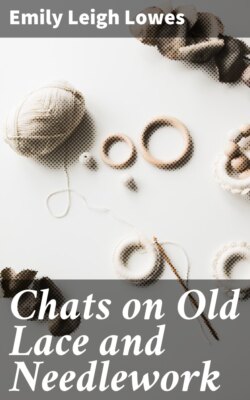Читать книгу Chats on Old Lace and Needlework - Emily Leigh Lowes - Страница 20
На сайте Литреса книга снята с продажи.
Valenciennes.
ОглавлениеTable of Contents
Valenciennes was formerly part of Flanders, being in the province of Hainault. It became a French town in 1668 by treaty. Being a Flemish town, the lace made there was purely Pillow lace, and in fineness of thread and beauty of design it rivalled in its early stages some of the fine old Flemish laces, which are more like ornamental cambric than anything else.
There are two kinds of Valenciennes lace, known as "Vraie" and "Fausse." These names are very misleading, as they merely denote the laces made in the town itself, or in the outskirts.
Early Valenciennes can only be distinguished from Flemish laces of the same age by the difference in the ground. By reference to the little chart of lace stitches the distinction will easily be seen, the Valenciennes being much closer and thicker in the plait, and having four threads on each side of its diamond-shaped mesh. Conventional scrolls and flowers were used as designs for the toile, the ground and the pattern being made at the same time.
This lace is said to have been worked, like that of Brussels, in dark, damp cellars, the moist atmosphere being necessary to prevent the tiny thread breaking. The lace-workers became nearly blind, and quite useless, long before they reached thirty years of age.
So expensive was the fabric that a pair of ruffles for a gentleman's coat would sell for 4,000 livres. Madame du Barri made extravagant use of this lovely lace. In her wardrobe accounts are mentioned, in 1771, head-dress, throatlets, fichus, and ruffles, "all plissé de Vraie Valenciennes." The amount of lace used for a head-dress alone is said to have cost 2,400 livres.
The "Vraie Valenciennes" was practically indestructible, earning the nickname of the "Eternal Valenciennes" from its durability. The well-to-do bourgeoise used to invest her savings in real lace, treasuring and wearing it on all best occasions for a lifetime.
The lace-makers of the town itself were so satisfied with their own lace that they proudly boasted that if a length commenced in the town of Valenciennes were taken and completed by the same worker, and with the same thread, outside their own damp atmosphere, the exact point of difference would be shown in the piece.
"OLD LILLE." (Author's Collection.)
The earliest Valenciennes laces show a closer design than that made later, which, by the way, many connoisseurs much prefer. The latter type is of clearer ground and more open design. The flowers do not follow the large scroll-like pattern of Flanders, but suggest the detached sprays and festoons of Alençon and Argentan. In both types there is no cord outlining either pattern or edge. All is flat as a piece of fine lawn.
